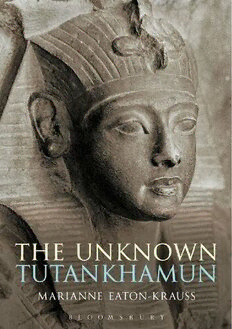Download The Unknown Tutankhamun PDF Free - Full Version
Download The Unknown Tutankhamun by Marianne Eaton-Krauss in PDF format completely FREE. No registration required, no payment needed. Get instant access to this valuable resource on PDFdrive.to!
About The Unknown Tutankhamun
The reign of Tutankhamun was of major significance in the history of ancient Egypt. Following Howard Carter’s discovery of the king’s tomb in 1922, the story of the boy who became Pharaoh, died young and was buried in splendor at the height of Egyptian civilization captivated generations. But there exists a wide discrepancy between that saga and what scholarship has discovered in the last few decades about Tutankhamun’s reign. A truer story is revealed, not by objects from his tomb, but by statuary, reliefs, paintings, and architecture from outside the Valley of the Kings.Marianne Eaton-Krauss, a leading authority on the boy king and the Amarna Period, guides readers through the recent findings of international research and the relevant documentation from a wide variety of sources, to create an accessible and comprehensive biography. Tracing Tutankhamun's life from birth to burial, she analyzes his parentage, his childhood as Prince Tutankhaten, his accession and change of name to Tutankhamun, his role in the restoration of the traditional cults and his own building projects, his death and burial, and the attitudes of his immediate successors to his reign.Illustrated with color and black-and-white images, the book includes extensive endnotes and selected bibliography, which will make it essential reading for students and scholars as well as anyone interested in Tutankhamun.The Unknown Tutankhamun paints a picture of the boy-king’s reign based on the material legacy associated with him – temple reliefs and wall paintings, statuary, and even the occasional seal impression, as well as the better known objects from his tomb such as the gold throne. An introduction sets the stage with a review of what was known about the king before Howard Carter’s discovery of his tomb in 1922, and the subsequent fate of the ‘treasure’. The future king’s parentage and the meager evidence for his upbringing are the subject of the initial chapter; the second chapter covers the time following his accession while he was still known by the name Tutankhaten, given him at birth, to conclude with a discussion of his complete five-part titulary known only in association with the altered name Tutankhamun. The focus of Chapter 3 is the reign’s program of restoring the name and figures of Amun, the traditional, orthodox King of the Gods whose cult had suffered attacks throughout Egypt under the ‘heretic’ pharaoh Akhenaten. Chapter 4 is devoted to the statuary commissioned by Tutankhamun – sculptures depicting Amun, standing or enthroned, alone or with one of his consorts Mut and Amunet, or accompanied by the king. Some sculptures of Tutankhamun himself as a priest of the god are also described and illustrated. In Chapter 5, the king’s own building projects are considered; many of them sought to link him to Amenhotep III, the last orthodox king who reigned before Akhenaten came to the throne. Chapter 6 argues that no preparations were made in advance for the eventual death and burial of the king; his quartzite sarcophagus was usurped; no tomb can be attributed to his initiative; and the building that functioned as his funerary temple may well have been founded to another purpose altogether. The final, seventh chapter takes up the story following Tutankhamun’s death – the stocking of his tomb, the closure of the sarcophagus, the painting of the walls of the Burial Chamber, the blocking of the entrance, and the filling of the corridor and stairway. An epilogue provides a sketch of what is known about the relationship of Ay and Horemhab, Tutankhamun’s first and second successors, to him and to each other. The book concludes with an epitome of Horemhab’s changing attitude towards Tutankhamun; by the end of his reign it was characterized, at least officially, by animosity, even if the king’s tomb was spared.
Detailed Information
| Author: | Marianne Eaton-Krauss |
|---|---|
| Publication Year: | 2016 |
| ISBN: | 9781472575630 |
| Pages: | 209 |
| Language: | English |
| File Size: | 3.834 |
| Format: | |
| Price: | FREE |
Safe & Secure Download - No registration required
Why Choose PDFdrive for Your Free The Unknown Tutankhamun Download?
- 100% Free: No hidden fees or subscriptions required for one book every day.
- No Registration: Immediate access is available without creating accounts for one book every day.
- Safe and Secure: Clean downloads without malware or viruses
- Multiple Formats: PDF, MOBI, Mpub,... optimized for all devices
- Educational Resource: Supporting knowledge sharing and learning
Frequently Asked Questions
Is it really free to download The Unknown Tutankhamun PDF?
Yes, on https://PDFdrive.to you can download The Unknown Tutankhamun by Marianne Eaton-Krauss completely free. We don't require any payment, subscription, or registration to access this PDF file. For 3 books every day.
How can I read The Unknown Tutankhamun on my mobile device?
After downloading The Unknown Tutankhamun PDF, you can open it with any PDF reader app on your phone or tablet. We recommend using Adobe Acrobat Reader, Apple Books, or Google Play Books for the best reading experience.
Is this the full version of The Unknown Tutankhamun?
Yes, this is the complete PDF version of The Unknown Tutankhamun by Marianne Eaton-Krauss. You will be able to read the entire content as in the printed version without missing any pages.
Is it legal to download The Unknown Tutankhamun PDF for free?
https://PDFdrive.to provides links to free educational resources available online. We do not store any files on our servers. Please be aware of copyright laws in your country before downloading.
The materials shared are intended for research, educational, and personal use in accordance with fair use principles.

